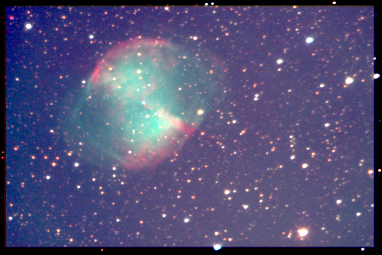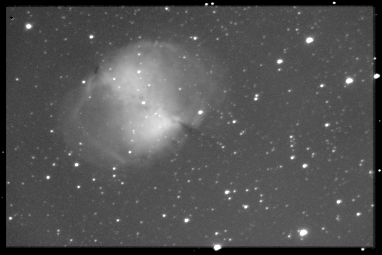

How to create of images in natural colours with standard photometric filters.
Dumbbell nebula (M 27) is a planetary nebula in Saggita constellation. Dumbbell is one from favourite objects for small telescopes, although its colours are too dim for visual observers.
A sample data are available as munipack-data-m27.tar.gz. Save it to arbitrary directory (for example /tmp/) like:
$ cd /tmp $ tar zxf munipack-data-m27.tar.gz $ cd munipack-data-m27/
The directory munipack-data-m27/ contains exposures in the instrumental colour system (nearly Johnson) in BVR filters and corresponding dark frames. B filter exposures has duration 60 seconds. Both V and R filter exposures has 40 seconds. Flat-fields frames are not available.
There is a complete list of Munipack's commands for composing of colour frame of Dumbbell nebula. This part prepares frames:
Prepare correction frames and pre-correct object's frames.
$ munipack dark -o d60.fits d60_*.fits $ munipack phcorr -dark d60.fits m27_*B.fits $ munipack dark -o d40.fits d40_*.fits $ munipack phcorr -dark d40.fits m27_*[VR].fits
$ munipack find m27_*.fits $ munipack aphot m27_*.fits
To check detected stars and its preliminary photometry, run xmunipack:
$ xmunipack m27_01R.fits
Search the reference astrometry catalogue around Dumbbell's position (required for astrometry calibration) in Virtual Observatory:
$ munipack cone -r 0.1 --magmin 10 --magmax 13 -- 299.87 22.71
Prepare the astrometric calibration of images
$ munipack astrometry m27_*.fits
Specify centre of projection of the output image. A good choice is a point near of centre of object; also the centre of a selected frame can be recommended. We has chooses α=299.9° and δ=22.72°. The specification of the common centre of projection (--rcen, --dcen) for all frames is important for correct alignment of all particular frames.
We are merging all images in single filter to get a deeper exposure:
$ munipack kombine -o m27_B.fits --rcen 299.9 --dcen 22.72 m27_*B.fits $ munipack kombine -o m27_V.fits --rcen 299.9 --dcen 22.72 m27_*V.fits $ munipack kombine -o m27_R.fits --rcen 299.9 --dcen 22.72 m27_*R.fits
To get proper colours, the final frames must be calibrated (this adds suffix _cal to original filenames):
$ munipack find m27_?.fits
$ munipack aphot m27_?.fits
$ for F in B V R; do
munipack phcal --verbose --photsys-ref Johnson --area 0.2 -c cone.fits \
-f $F --col-mag ${F}mag --col-magerr e_${F}mag m27_${F}.fits
done
Once data are kombined into a deep exposure frames, everything is prepared for colouring.
A direct way to compose a frame in natural colours is to select a white star, the star with its colour index near zero: our suitable white star is at pixel coordinates (391,54):
$ munipack colouring --white-star 391,54 m27_B.fits m27_V.fits m27_R.fits
It leaves frame in colouring.fits. Be carefull, result does depends on proper choice of the white star. Option --white-radius, and --backs can be used for fine tuning.
More simple way is offered by calibrated frames:
$ munipack colouring m27_B_cal.fits m27_V_cal.fits m27_R_cal.fits
The photometry calibration of frames does job for us, the calibrated frames has balanced the white, by definition.


The output image nicely shows regions where radiation by forbidden lines dominates (green) and Hα regions heated by shock-waves (red).
Also, try how this image would be visible by human vision at night, when colour vision receptors (rods) is not activated. The appearance will be similar to visual sights. Use xmunipack and Tune->Colour_menu, or try helper utility:
$ fitspng -l 100,7e3 m27.fits $ fitspng -l 100,7e3 -n 1e9,1e3 m27.fits
The image, by scotopic vision, is near to the pictures drawn by observers from the past, and looks more like a dumbbell.
Manuals: Colouring, Kombine, Astrometry, Aperture Photometry, Photometry pre-corrections.
Tutorial: Image Compositions and the shell script m27.sh.